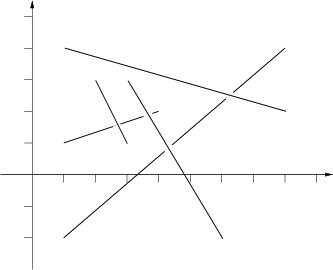poj 2653 Pick-up sticks 计算几何
Pick-up sticks
| Time Limit: 3000MS | Memory Limit: 65536K | |
| Total Submissions: 12401 | Accepted: 4677 |
Description
Stan has n sticks of various length. He throws them one at a time on the floor in a random way. After finishing throwing, Stan tries to find the top sticks, that is these sticks such that there is no stick on top of them. Stan has noticed that the last thrown stick is always on top but he wants to know all the sticks that are on top. Stan sticks are very, very thin such that their thickness can be neglected.
Input
Input consists of a number of cases. The data for each case start with 1 <= n <= 100000, the number of sticks for this case. The following n lines contain four numbers each, these numbers are the planar coordinates of the endpoints of one stick. The sticks are listed in the order in which Stan has thrown them. You may assume that there are no more than 1000 top sticks. The input is ended by the case with n=0. This case should not be processed.
Output
For each input case, print one line of output listing the top sticks in the format given in the sample. The top sticks should be listed in order in which they were thrown.
The picture to the right below illustrates the first case from input.
The picture to the right below illustrates the first case from input.

Sample Input
5 1 1 4 2 2 3 3 1 1 -2.0 8 4 1 4 8 2 3 3 6 -2.0 3 0 0 1 1 1 0 2 1 2 0 3 1 0
Sample Output
Top sticks: 2, 4, 5. Top sticks: 1, 2, 3.
Hint
Huge input,scanf is recommended.
题意:按先后顺序给你n条线段,判断哪些线段在最上面
思路:先按顺序存入所有线段记为1到n,因为最后一条线段一定在最上面,所以我们可以从第n条扫到第1条,记为i,然后从第n条一直到第i+1条线段判断是否与它相交,如果是,那么第i条线段一定不在最上面,否则一定在最上面
#include<iostream>
#include<cstdio>
#include<cmath>
using namespace std;
struct Point //点
{
double x,y;
Point (double a=0,double b=0):x(a),y(b) {}
};
struct Line_segment //线段
{
Point s,e;
Line_segment() {}
Line_segment(Point a,Point b):s(a),e(b) {}
} a[100001];
inline double Max(double a,double b)
{
return a>b?a:b;
}
inline double Min(double a,double b)
{
return a<b?a:b;
}
double multiply(Point sp,Point ep,Point op)
{
return((sp.x-op.x)*(ep.y-op.y)-(ep.x-op.x)*(sp.y-op.y));
}
bool intersect(Line_segment u,Line_segment v)
{
return((Max(u.s.x,u.e.x)>=Min(v.s.x,v.e.x))&&
(Max(v.s.x,v.e.x)>=Min(u.s.x,u.e.x))&&
(Max(u.s.y,u.e.y)>=Min(v.s.y,v.e.y))&&
(Max(v.s.y,v.e.y)>=Min(u.s.y,u.e.y))&&
(multiply(v.s,u.e,u.s)*multiply(u.e,v.e,u.s)>=0)&&
(multiply(u.s,v.e,v.s)*multiply(v.e,u.e,v.s)>=0));
}
bool jug[100001];
int main()
{
int n,i,j;
while(~scanf("%d",&n))
{
if(n==0) break;
for(i=0; i<n; i++)
jug[i]=1;
for(i=0; i<n; i++)
scanf("%lf %lf %lf %lf",&a[i].e.x,&a[i].e.y,&a[i].s.x,&a[i].s.y);
for(i=n-1; i>=0; i--)
{
for(j=i+1; j<n; j++)
if(intersect(a[i],a[j])==1)
{
jug[i]=0;
break;
}
}
printf("Top sticks: ");
for(i=0; i<n; i++)
if(jug[i]==1)
{
printf("%d",i+1);
i++;
break;
}
for(; i<n; i++)
if(jug[i]==1) printf(", %d",i+1);
printf(".\n");
}
return 0;
}








 本文介绍了一道名为Pick-upsticks的计算几何题目,该题要求找出在一系列随机投掷的线段中哪些线段位于最顶层。文章提供了一个有效的算法思路及完整的C++实现代码,通过逆序检查每根线段来确定其是否被其他线段覆盖。
本文介绍了一道名为Pick-upsticks的计算几何题目,该题要求找出在一系列随机投掷的线段中哪些线段位于最顶层。文章提供了一个有效的算法思路及完整的C++实现代码,通过逆序检查每根线段来确定其是否被其他线段覆盖。
















 1657
1657

 被折叠的 条评论
为什么被折叠?
被折叠的 条评论
为什么被折叠?








